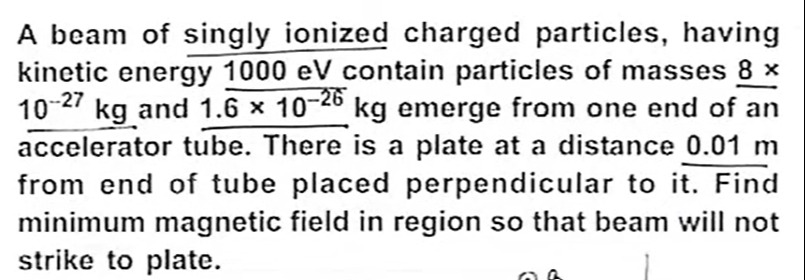Question
Question: A beam of singly ionized charged particles, having kinetic energy 1000 eV contain particles of masse...
A beam of singly ionized charged particles, having kinetic energy 1000 eV contain particles of masses 8×10−27 kg and 1.6×10−26 kg emerge from one end of an accelerator tube. There is a plate at a distance 0.01 m from end of tube placed perpendicular to it. Find minimum magnetic field in region so that beam will not strike to plate.

1 Tesla
Solution
The radius of the circular path of a charged particle in a magnetic field is given by r=qBmv. For the particle to not strike the plate at distance d, its radius of curvature must satisfy r≥d. Substituting v=2KE/m, we get r=qB12mKE. The condition r≥d becomes B≤qd12mKE. We calculate this upper bound for B for each mass. The kinetic energy is KE=1000 eV=1000×(1.6×10−19 J/eV)=1.6×10−16 J. The charge of a singly ionized particle is q=e=1.6×10−19 C. The distance to the plate is d=0.01 m.
For mass m1=8×10−27 kg: Bmax1=qd12m1KE=(1.6×10−19 C)(0.01 m)12×(8×10−27 kg)×(1.6×10−16 J) Bmax1=1.6×10−21125.6×10−43=1.6×10−2112.56×10−42 Bmax1=1.6×10−211.6×10−21=1 Tesla.
For mass m2=1.6×10−26 kg: Bmax2=qd12m2KE=(1.6×10−19 C)(0.01 m)12×(1.6×10−26 kg)×(1.6×10−16 J) Bmax2=1.6×10−2115.12×10−42=1.6×10−215.12×10−21 Bmax2=1.62.2627≈1.414 Tesla.
For the entire beam to miss the plate, the condition B≤Bmax must hold for both particles. Thus, B≤1 T and B≤1.414 T. The combined condition is B≤1 T. The minimum magnetic field required to ensure the beam does not strike the plate is the boundary value where the particle with the most restrictive condition just misses the plate, which is B=1 T.
